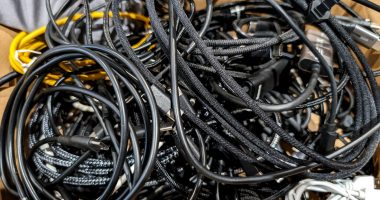A GROUP of astronomers have joined forces in a bid to prevent billionaires like Elon Musk from flooding the skies with obstructive satellites.
Experts say thousands of objects in Low Earth Orbit are making it harder for them to see into space, meaning they will struggle to spot killer asteroids hurtling towards us.
Others have warned that in extreme cases, it could create a catastrophic clutter of space debris effectively making it impossible to leave the planet.
Musk’s SpaceX and Jeff Bezos’s Project Kuiper are just a handful of big names vying for the skies as part of an effort to provide broadband to hard-to-reach areas.
SpaceX Starlink already has some 2,000 satellites up, but Musk has much bigger plans to the tune of 42,000.
Some effort has been made to address the issue, by applying coatings and shielding that help to reduce the glow from satellites.
But scientists studying space say there are now so many they have become worse than light pollution from big urban areas on the ground.
The reflection from satellites can make it tricky for experts to spot things and even block the view for telescopes.
Experts have previously fled to remote locations in Chile, Australia and South Africa to carry out their critical work away from light, but satellites orbiting the planet have scuppered that.
So now astronomers want to ramp up the pressure, forming a new centre within the major International Astronomical Union (IAU).
“In the past, the main source of interference was the light pollution produced by the urban illumination, the so-called artificial light at night,” said centre director Piero Benvenuti.
“But more recently, the impact of the large constellations of communication satellites became a more serious concern because of their ubiquitous invasiveness.”
There are other players in the internet space race too, including OneWeb which already has a constellation of 650 satellites – though they are further up to make it less congested.
“By the end of the decade, more than 5,000 satellites will be above the horizon at any given time,” warned Connie Walker, a co-director of the new centre.
“At a typical dark sky observatory location, a few hundred to several thousand of these satellites will be illuminated by the Sun.”
The aim of the IAU’s new Centre for the Protection of the Dark and Quiet Sky is to bring together astronomers, satellite operators, regulators and the wider community.
It comes after a new study claimed the bright glare from satellites is affecting images used to spot potentially dangerous asteroids,
There are also fears a catastrophic clutter of space debris left behind by satellites could potentially block rockets from leaving Earth, an effect known as “Kessler Syndrome”.
Kessler Syndrome is a concept thought up by the Nasa scientist Donald J. Kessler.
It refers to the idea that a chain reaction of exploding space debris could create so much space junk in the Low Earth Orbit that we’d be trapped on Earth.
Experts recently called out “stupid” regimes like Russia for deliberately blowing up spacecraft, saying it too risks making space unusable.
What is Starlink?
Starlink is a satellite project launched by billionaire SpaceX CEO Elon Musk in 2015.
Musk intends to put 12,000 satellites into Earth’s orbit over next decade, possibly rising to 42,000 in future.
The “mega-constellation” will eventually be able to beam internet coverage to anywhere on the planet, according to SpaceX.
The California company says its network will provide users with high-speed, low-latency internet coverage.
Latency is the time it takes to send data from one point to the next.
People in remote areas of the US and UK are already using Starlink instead of traditional cabled broadband.
Because Starlink sats are 60 times closer to Earth than most satellites, SpaceX’s WiFi latency is lower than traditional satellite internet.
The firm sends its satellites up in batches of 60 at a time.
They’re launched from Cape Carnaveral in Florida atop unmanned Falcon 9 rockets, which are also built by SpaceX.
The effect of the low-orbiting tech on views of the night sky is a major concern, as they appear brighter than many stars and planets.
Astronomers and amateur stargazers have repeatedly blasted SpaceX for ruining their observations.
The company argues that its satellites are only bright shortly after launch because they sit in a low orbit.
Over several weeks, the satellites move further from Earth, apparently dampening their effect on space observations.
In other news, Apple has revealed a bunch of new emoji for iPhone, including a pregnant man and two saucy symbols.
Experts have warned that future space launches could be jeopardised if “stupid” regimes like Russia don’t stop blasting the skies creating debris.
And the most popular phone since the millennium has been unveiled, with many shocked to find out it’s not an iPhone.
We pay for your stories! Do you have a story for The Sun Online Tech & Science team? Email us at [email protected]
This post first appeared on Thesun.co.uk













